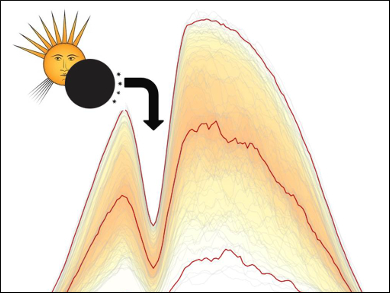Germany has become one of the leaders in incorporating renewable energy sources through its well-publicized energy transition movement or “Energiewende”. One of the most important challenges to the utilization of renewable energy (such as solar power) is the smoothing out of the electrical production so that we can continue to use electricity without interruption, even when the sun is not shining.
Sharp changes in energy production can cause grid instability or power disruption if other power sources are not able to compensate in real time. As the installed photovoltaic capacity in Germany has increased to 90 Gigawatts today (compared to just 1 Gigawatt during the last solar eclipse), the 2015 solar eclipse presented the German electrical grid with its biggest challenge up to this point.
According to a study by Sven Killinger and colleagues, Fraunhofer Institute for Solar Energy Systems, Freiburg, Germany, the German electrical power grid withstood the rapid changes in solar irradiation that resulted from the 2015 solar eclipse despite the disruption of energy production from photovoltaics. The results are based on a simulation that incorporated collected data from 160 photovoltaic installations throughout Germany and show that importing electrical power from neighboring countries is one of the most important factors for stabilizing the electrical grid with a high contribution from renewable energy technologies.
Thus the high incorporation of renewable energy sources in Germany passed its latest test, which bodes well for the global energy transition going forward, in spite of any celestial interference from the moon.
- Impact of the Solar Eclipse from 20th March 2015 on the German Electrical Supply – Simulation and Analysis,
Sven Killinger, Niklas Kreifels, Bruno Burger, Björn Müller, George Stiff, Christof Wittwer,
Energy Technol. 2015.
DOI: 10.1002/ente.201500228




